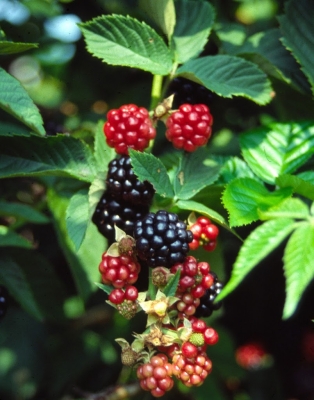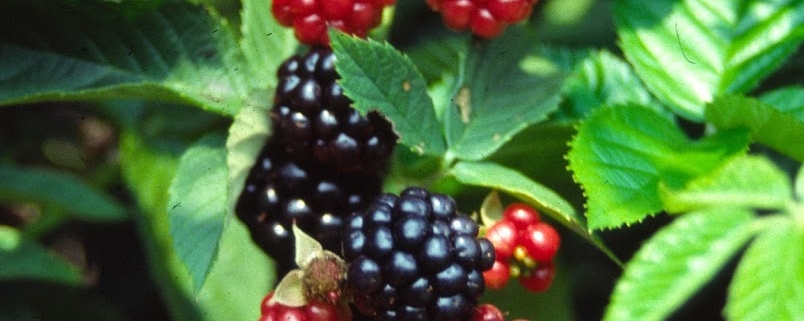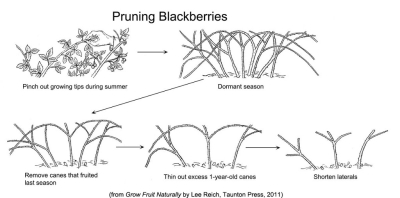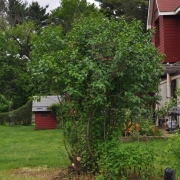Blackberries Galore!
UPCOMING WORKSHOP WITH LEE:
Philadelphia Orchard Project, 8/22,
http://www.phillyorchards.org/volunteer/schedule,
Fruit Growing Simplified
http://www.phillyorchards.org/volunteer/schedule,
Fruit Growing Simplified
If your fingers aren’t stained after you’ve picked blackberries, you’re not eating them at their very best. And this is the year — my year, at least — for blackberries. Spring weather threw a curve ball that pretty much wiped out my developing apples, hardy kiwifruits, and pears, but blackberries are among a number of other fruits that waited patiently in spring, and whose branches are now bowed to the ground under a heavy load of fruit. An especially heavy load due to a mild winter? abundant rain (to say the least, from hurricane Irene and tropical storm Lee) late last summer? my green thumb? Who knows?
After succumbing to temptation and plucking a few of the first blackberries of the season underripe, I can wait for finger-staining ripeness. Coming upon a fully colored blackberry, I give it a gentle pull. A dead ripe berry should drop into your hand with only the slightest coaxing. Eat.
 |
| Chester blackberry ripening |
In the wild, blackberries are found growing almost everywhere. Some of these wild plants creep along the ground, while others grow upright like small trees. These growth habits have been bred into cultivated blackberries, so you can choose from erect varieties, which are the most cold-hardy and heat tolerant, as well as semi-trailing and trailing varieties. Trailing varieties, with lanky, flexible canes, are sometimes called “dewberries.” Western trailing blackberries yield large, wine-colored to black fruits having distinctive flavors. Varieties also have even been selected or developed that lack those ominous thorns.
Blackberries have perennial roots and biennial canes. With most varieties, a cane bears fruits in its second season, then dies. In any growing season, as older canes are fruiting, then dying, new ones are making their first season of growth. Any planting, then, has both one and two-year old canes, so offers an annual harvest. The plants spread by tip layering, that is, by hopscotching along as arching or trailing canes root at their tips and make whole new plants which go on to tip layer and make more plants, as so on. Unfettered, blackberries grow to become a tangled patch of canes.
—————————————————
Although wild blackberries often grow along the partially shaded edges of woods, the plants fruit best and are healthiest in full sunlight. As with most cultivated plants, well-drained soil rich in organic matter is the ideal.
Spacing, which may be as close as 3 ft. apart to more than 6 ft. apart, depends on the type of blackberry and the training system. Erect blackberries are self-supporting, but other types are easier to manage if trained by being tied up to a sturdy pole, on a trellis of wires strung between sturdy posts, or on a fence.
Blackberrys’ biennial canes and their aggressive spread make a case for annual pruning. On all but the trailing or trellised semi-erect types, prune twice each year. The first pruning takes place during summer; the tip of each new cane needs to be nipped off just as it reaches a height of 3 ft. Pinching causes branching and helps keep plants upright.
The second round of pruning, for all types of blackberries, takes place in late winter, just before growth begins. Any cane that bore fruit the previous season is cut down to the ground and the number of new canes is reduced to about 6 per clump. Finally, those lateral induced by summer nipping: They are shortened to about 18 in.
A convenient way to manage the long canes of trailing types is to let new canes trail on the ground, which they are anyway wont to do, lifting the second year canes, which will fruit, up to the wire of a trellis. If winter cold is a potential problem, those reclining canes can be left on the ground where they are easily protected for winter with a blanket of straw or leaves. Late the following winter, the old canes that fruited are cut away, the younger canes are lifted up onto the trellis, for fruiting, and new canes that season are allowed to trail on the ground. And so on year after year – all much more fun if canes are thornless.
—————————————
The nice thing about blackberries is that they have few debilitating pest or disease problems. Start with healthy plants from a nursery; neighbors’ plants could harbor latent diseases, especially with age (the plants’, not the neighbors’). Prune regularly so branches can bathe in light and air, and remove any canes harboring insects or diseases. And pick berries when fully ripe.
————————————-
In the cold pocket, where I live and garden, I’m somewhat restricted in the spectrum of blackberry varieties I can grow. I also have an aversion to blackberries’ intimidating thorns, which arm even the leaves, all with reverse barbs to really grab you. Years ago, I traded in the delectable, but thorny, Darrow plants for my present Chester blackberries, which are the most cold-hardy of the thornless varieties. I also grow Doyle thornless, which makes long, trailing canes that I can sometimes lay on the ground to be covered by mulch or snow for winter protection.
The thornlessness of thornless blackberries is, in my opinion, beauty in of itself. It’s not just that these plants are non-intimidating; the smooth, greenish stems and lush green leaves really are quite ornamental, and made more so as a background for spring’s large white blossoms.
See my book GROW FRUIT NATURALLY for more detail on varieties and cultivation of blackberries, which can be grown just about everywhere with appropriate choice of varieties.







Hello Mr. Reich,
Could the pruning technique for blackberries be used for raspberries as well?
Thanks!
The technique could be used for black raspberries (blackcaps). Red (and yellow) raspberries are pruned slightly differently.
Lee,
What is the best way to propagate blackberries?
Thanks!
When the canes arch over and their tips touch the ground, roots form at the tips. In autumn, cut the tips from the mother plants, dig them up, and replant.
Will semi-erect and erect blackberries tip over, touch the ground and root? If not, how can they be propagated?
Semi-erect will sometimes touch the ground, perhaps the erect ones also. You could just carefully bend either to the ground to tip layer. Or dig up the clump when dormant and divide it into a few plants, and replant them.
I have black raspberry bushes all throughout a property of mine. I want to try to get them more centrally located. There are hundreds of them strewn throughout a big second lot I have. Can I just dig them up and locate them in another area, regardless of how big, tall, short, old, or new they are? I assume they all have a clump. If i just dig it up and replant them nearer to my home, is that ok? WHEN should I do this?
Yes, you could do it — now, before they leaf out too much.